ITECH 5500 - In-Depth Analysis of Self-Efficacy: A Literature Review
VerifiedAdded on 2023/06/12
|7
|2108
|314
Literature Review
AI Summary
This document presents a literature review on self-efficacy, a critical trait for personal and professional success, especially within the IT sector. It defines self-efficacy as the belief in one's capabilities to achieve goals and highlights its importance in fostering optimism, viewing challenges as opportunities, and recovering from setbacks. The review differentiates self-efficacy from general efficacy and discusses key factors influencing it, such as mastery experiences, observations, and social persuasion. It also examines the role of computer self-efficacy in IT adoption, the impact of IT self-efficacy on job satisfaction in healthcare, and the linkage between self-efficacy and workplace spirituality in IT organizations. The review concludes that higher self-efficacy levels are directly linked to better performance, increased motivation, and job satisfaction in the IT industry. The document also includes a personal reflection on the role of self-efficacy in academic and professional life, along with strategies for improving self-efficacy, such as IT training, self-reflection, and social persuasion. Desklib provides past papers and solved assignments for students.

qwertyuiopasdfghjklzxcvbnmqw
ertyuiopasdfghjklzxcvbnmqwert
yuiopasdfghjklzxcvbnmqwertyui
opasdfghjklzxcvbnmqwertyuiop
asdfghjklzxcvbnmqwertyuiopasd
fghjklzxcvbnmqwertyuiopasdfgh
jklzxcvbnmqwertyuiopasdfghjkl
zxcvbnmqwertyuiopasdfghjklzxc
vbnmqwertyuiopasdfghjklzxcvb
nmqwertyuiopasdfghjklzxcvbnm
qwertyuiopasdfghjklzxcvbnmqw
ertyuiopasdfghjklzxcvbnmqwert
yuiopasdfghjklzxcvbnmqwertyui
opasdfghjklzxcvbnmqwertyuiop
asdfghjklzxcvbnmqwertyuiopasd
fghjklzxcvbnmqwertyuiopasdfgh
jklzxcvbnmrtyuiopasdfghjklzxcv
Self-Efficacy
Literature Review
5/2/2018
ertyuiopasdfghjklzxcvbnmqwert
yuiopasdfghjklzxcvbnmqwertyui
opasdfghjklzxcvbnmqwertyuiop
asdfghjklzxcvbnmqwertyuiopasd
fghjklzxcvbnmqwertyuiopasdfgh
jklzxcvbnmqwertyuiopasdfghjkl
zxcvbnmqwertyuiopasdfghjklzxc
vbnmqwertyuiopasdfghjklzxcvb
nmqwertyuiopasdfghjklzxcvbnm
qwertyuiopasdfghjklzxcvbnmqw
ertyuiopasdfghjklzxcvbnmqwert
yuiopasdfghjklzxcvbnmqwertyui
opasdfghjklzxcvbnmqwertyuiop
asdfghjklzxcvbnmqwertyuiopasd
fghjklzxcvbnmqwertyuiopasdfgh
jklzxcvbnmrtyuiopasdfghjklzxcv
Self-Efficacy
Literature Review
5/2/2018
Paraphrase This Document
Need a fresh take? Get an instant paraphrase of this document with our AI Paraphraser
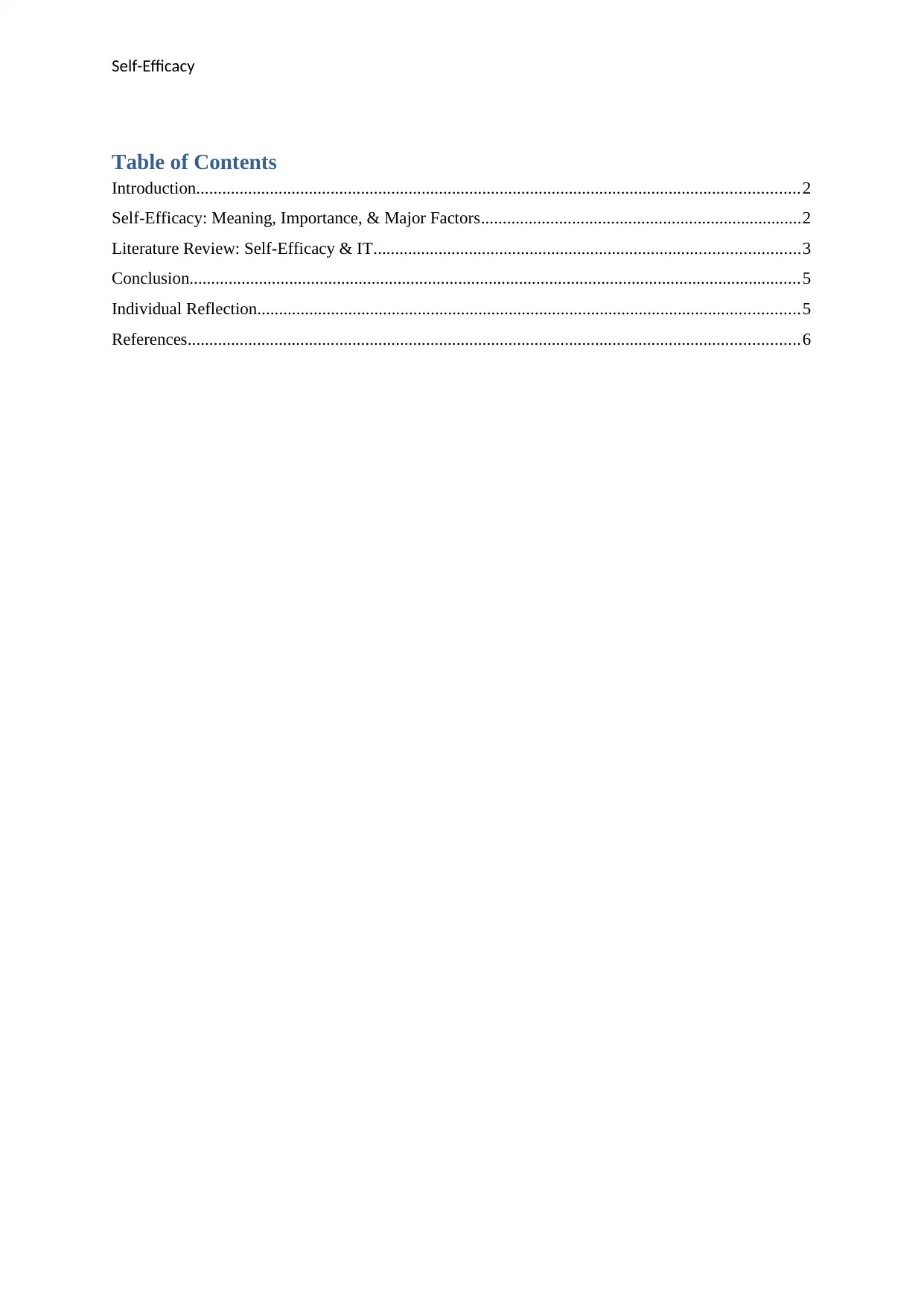
Self-Efficacy
Table of Contents
Introduction...........................................................................................................................................2
Self-Efficacy: Meaning, Importance, & Major Factors..........................................................................2
Literature Review: Self-Efficacy & IT..................................................................................................3
Conclusion.............................................................................................................................................5
Individual Reflection.............................................................................................................................5
References.............................................................................................................................................6
Table of Contents
Introduction...........................................................................................................................................2
Self-Efficacy: Meaning, Importance, & Major Factors..........................................................................2
Literature Review: Self-Efficacy & IT..................................................................................................3
Conclusion.............................................................................................................................................5
Individual Reflection.............................................................................................................................5
References.............................................................................................................................................6
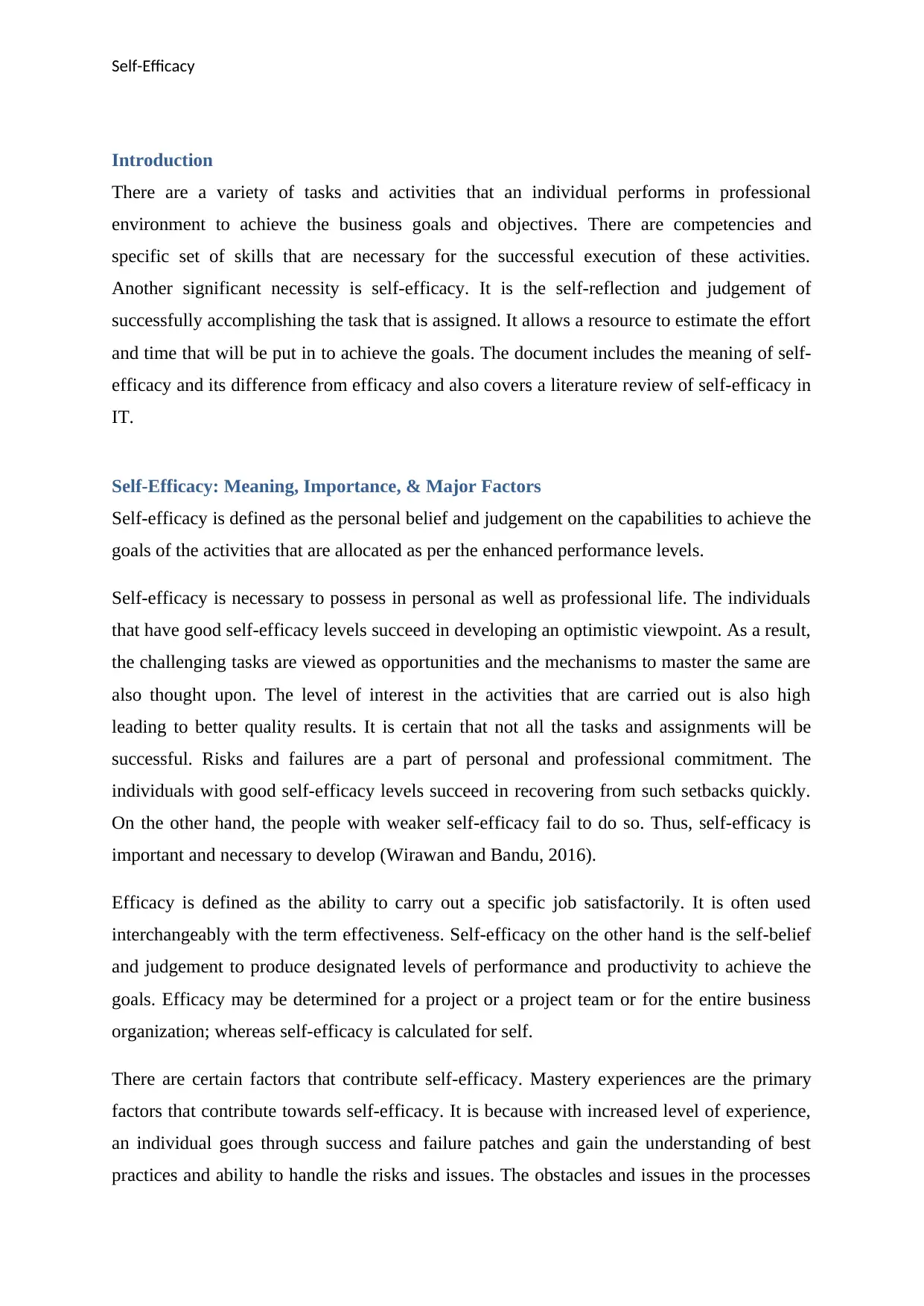
Self-Efficacy
Introduction
There are a variety of tasks and activities that an individual performs in professional
environment to achieve the business goals and objectives. There are competencies and
specific set of skills that are necessary for the successful execution of these activities.
Another significant necessity is self-efficacy. It is the self-reflection and judgement of
successfully accomplishing the task that is assigned. It allows a resource to estimate the effort
and time that will be put in to achieve the goals. The document includes the meaning of self-
efficacy and its difference from efficacy and also covers a literature review of self-efficacy in
IT.
Self-Efficacy: Meaning, Importance, & Major Factors
Self-efficacy is defined as the personal belief and judgement on the capabilities to achieve the
goals of the activities that are allocated as per the enhanced performance levels.
Self-efficacy is necessary to possess in personal as well as professional life. The individuals
that have good self-efficacy levels succeed in developing an optimistic viewpoint. As a result,
the challenging tasks are viewed as opportunities and the mechanisms to master the same are
also thought upon. The level of interest in the activities that are carried out is also high
leading to better quality results. It is certain that not all the tasks and assignments will be
successful. Risks and failures are a part of personal and professional commitment. The
individuals with good self-efficacy levels succeed in recovering from such setbacks quickly.
On the other hand, the people with weaker self-efficacy fail to do so. Thus, self-efficacy is
important and necessary to develop (Wirawan and Bandu, 2016).
Efficacy is defined as the ability to carry out a specific job satisfactorily. It is often used
interchangeably with the term effectiveness. Self-efficacy on the other hand is the self-belief
and judgement to produce designated levels of performance and productivity to achieve the
goals. Efficacy may be determined for a project or a project team or for the entire business
organization; whereas self-efficacy is calculated for self.
There are certain factors that contribute self-efficacy. Mastery experiences are the primary
factors that contribute towards self-efficacy. It is because with increased level of experience,
an individual goes through success and failure patches and gain the understanding of best
practices and ability to handle the risks and issues. The obstacles and issues in the processes
Introduction
There are a variety of tasks and activities that an individual performs in professional
environment to achieve the business goals and objectives. There are competencies and
specific set of skills that are necessary for the successful execution of these activities.
Another significant necessity is self-efficacy. It is the self-reflection and judgement of
successfully accomplishing the task that is assigned. It allows a resource to estimate the effort
and time that will be put in to achieve the goals. The document includes the meaning of self-
efficacy and its difference from efficacy and also covers a literature review of self-efficacy in
IT.
Self-Efficacy: Meaning, Importance, & Major Factors
Self-efficacy is defined as the personal belief and judgement on the capabilities to achieve the
goals of the activities that are allocated as per the enhanced performance levels.
Self-efficacy is necessary to possess in personal as well as professional life. The individuals
that have good self-efficacy levels succeed in developing an optimistic viewpoint. As a result,
the challenging tasks are viewed as opportunities and the mechanisms to master the same are
also thought upon. The level of interest in the activities that are carried out is also high
leading to better quality results. It is certain that not all the tasks and assignments will be
successful. Risks and failures are a part of personal and professional commitment. The
individuals with good self-efficacy levels succeed in recovering from such setbacks quickly.
On the other hand, the people with weaker self-efficacy fail to do so. Thus, self-efficacy is
important and necessary to develop (Wirawan and Bandu, 2016).
Efficacy is defined as the ability to carry out a specific job satisfactorily. It is often used
interchangeably with the term effectiveness. Self-efficacy on the other hand is the self-belief
and judgement to produce designated levels of performance and productivity to achieve the
goals. Efficacy may be determined for a project or a project team or for the entire business
organization; whereas self-efficacy is calculated for self.
There are certain factors that contribute self-efficacy. Mastery experiences are the primary
factors that contribute towards self-efficacy. It is because with increased level of experience,
an individual goes through success and failure patches and gain the understanding of best
practices and ability to handle the risks and issues. The obstacles and issues in the processes
⊘ This is a preview!⊘
Do you want full access?
Subscribe today to unlock all pages.

Trusted by 1+ million students worldwide
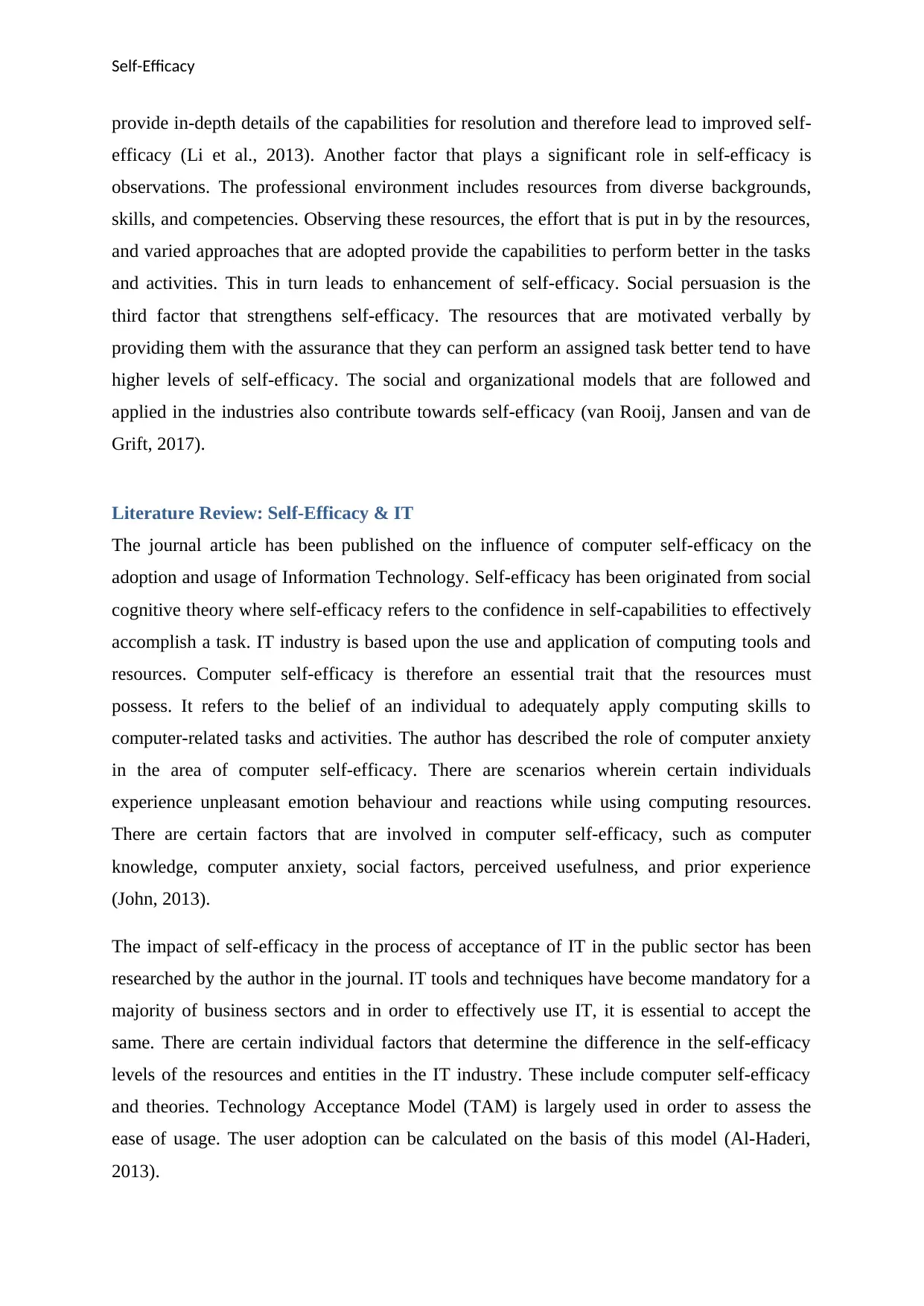
Self-Efficacy
provide in-depth details of the capabilities for resolution and therefore lead to improved self-
efficacy (Li et al., 2013). Another factor that plays a significant role in self-efficacy is
observations. The professional environment includes resources from diverse backgrounds,
skills, and competencies. Observing these resources, the effort that is put in by the resources,
and varied approaches that are adopted provide the capabilities to perform better in the tasks
and activities. This in turn leads to enhancement of self-efficacy. Social persuasion is the
third factor that strengthens self-efficacy. The resources that are motivated verbally by
providing them with the assurance that they can perform an assigned task better tend to have
higher levels of self-efficacy. The social and organizational models that are followed and
applied in the industries also contribute towards self-efficacy (van Rooij, Jansen and van de
Grift, 2017).
Literature Review: Self-Efficacy & IT
The journal article has been published on the influence of computer self-efficacy on the
adoption and usage of Information Technology. Self-efficacy has been originated from social
cognitive theory where self-efficacy refers to the confidence in self-capabilities to effectively
accomplish a task. IT industry is based upon the use and application of computing tools and
resources. Computer self-efficacy is therefore an essential trait that the resources must
possess. It refers to the belief of an individual to adequately apply computing skills to
computer-related tasks and activities. The author has described the role of computer anxiety
in the area of computer self-efficacy. There are scenarios wherein certain individuals
experience unpleasant emotion behaviour and reactions while using computing resources.
There are certain factors that are involved in computer self-efficacy, such as computer
knowledge, computer anxiety, social factors, perceived usefulness, and prior experience
(John, 2013).
The impact of self-efficacy in the process of acceptance of IT in the public sector has been
researched by the author in the journal. IT tools and techniques have become mandatory for a
majority of business sectors and in order to effectively use IT, it is essential to accept the
same. There are certain individual factors that determine the difference in the self-efficacy
levels of the resources and entities in the IT industry. These include computer self-efficacy
and theories. Technology Acceptance Model (TAM) is largely used in order to assess the
ease of usage. The user adoption can be calculated on the basis of this model (Al-Haderi,
2013).
provide in-depth details of the capabilities for resolution and therefore lead to improved self-
efficacy (Li et al., 2013). Another factor that plays a significant role in self-efficacy is
observations. The professional environment includes resources from diverse backgrounds,
skills, and competencies. Observing these resources, the effort that is put in by the resources,
and varied approaches that are adopted provide the capabilities to perform better in the tasks
and activities. This in turn leads to enhancement of self-efficacy. Social persuasion is the
third factor that strengthens self-efficacy. The resources that are motivated verbally by
providing them with the assurance that they can perform an assigned task better tend to have
higher levels of self-efficacy. The social and organizational models that are followed and
applied in the industries also contribute towards self-efficacy (van Rooij, Jansen and van de
Grift, 2017).
Literature Review: Self-Efficacy & IT
The journal article has been published on the influence of computer self-efficacy on the
adoption and usage of Information Technology. Self-efficacy has been originated from social
cognitive theory where self-efficacy refers to the confidence in self-capabilities to effectively
accomplish a task. IT industry is based upon the use and application of computing tools and
resources. Computer self-efficacy is therefore an essential trait that the resources must
possess. It refers to the belief of an individual to adequately apply computing skills to
computer-related tasks and activities. The author has described the role of computer anxiety
in the area of computer self-efficacy. There are scenarios wherein certain individuals
experience unpleasant emotion behaviour and reactions while using computing resources.
There are certain factors that are involved in computer self-efficacy, such as computer
knowledge, computer anxiety, social factors, perceived usefulness, and prior experience
(John, 2013).
The impact of self-efficacy in the process of acceptance of IT in the public sector has been
researched by the author in the journal. IT tools and techniques have become mandatory for a
majority of business sectors and in order to effectively use IT, it is essential to accept the
same. There are certain individual factors that determine the difference in the self-efficacy
levels of the resources and entities in the IT industry. These include computer self-efficacy
and theories. Technology Acceptance Model (TAM) is largely used in order to assess the
ease of usage. The user adoption can be calculated on the basis of this model (Al-Haderi,
2013).
Paraphrase This Document
Need a fresh take? Get an instant paraphrase of this document with our AI Paraphraser
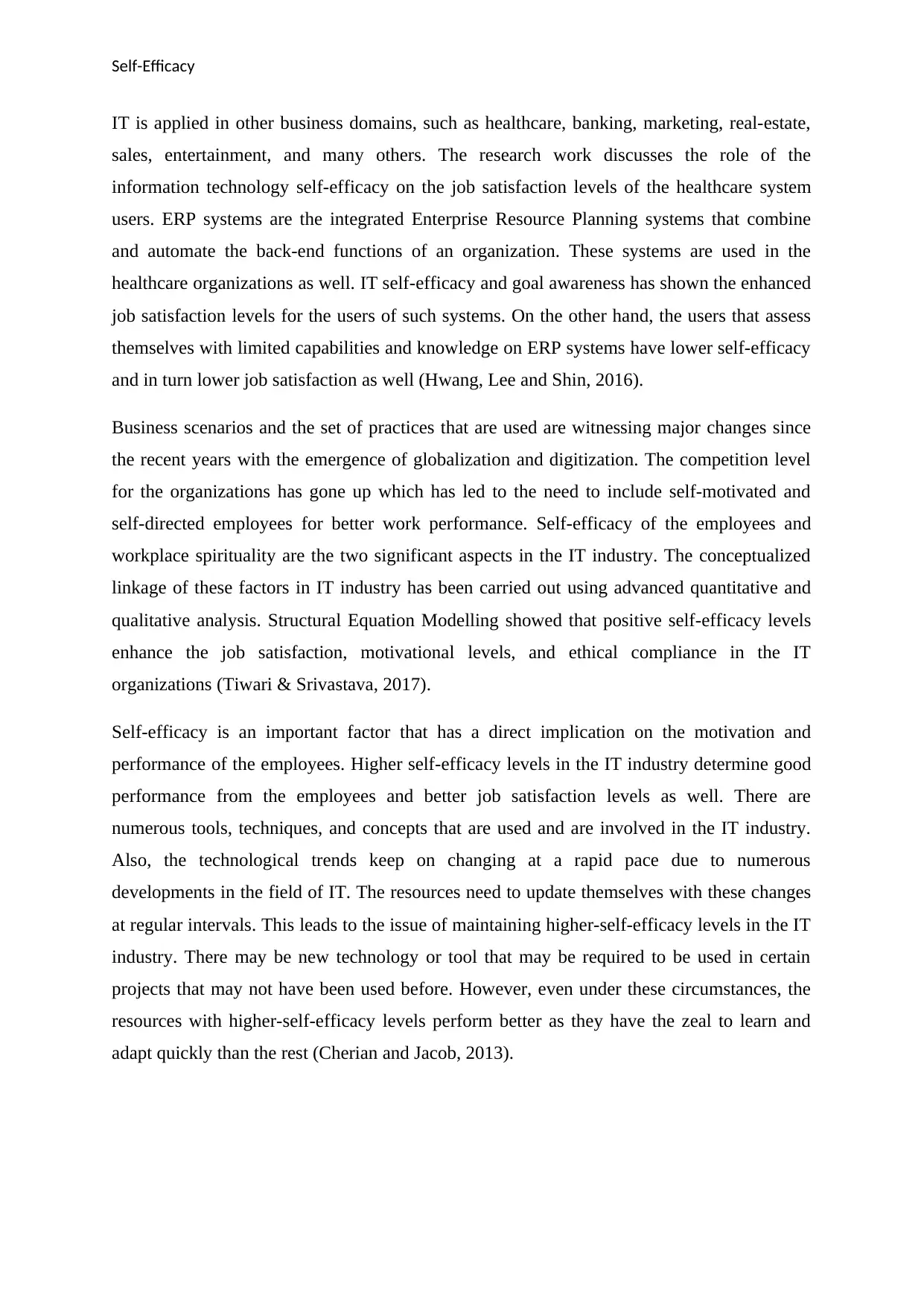
Self-Efficacy
IT is applied in other business domains, such as healthcare, banking, marketing, real-estate,
sales, entertainment, and many others. The research work discusses the role of the
information technology self-efficacy on the job satisfaction levels of the healthcare system
users. ERP systems are the integrated Enterprise Resource Planning systems that combine
and automate the back-end functions of an organization. These systems are used in the
healthcare organizations as well. IT self-efficacy and goal awareness has shown the enhanced
job satisfaction levels for the users of such systems. On the other hand, the users that assess
themselves with limited capabilities and knowledge on ERP systems have lower self-efficacy
and in turn lower job satisfaction as well (Hwang, Lee and Shin, 2016).
Business scenarios and the set of practices that are used are witnessing major changes since
the recent years with the emergence of globalization and digitization. The competition level
for the organizations has gone up which has led to the need to include self-motivated and
self-directed employees for better work performance. Self-efficacy of the employees and
workplace spirituality are the two significant aspects in the IT industry. The conceptualized
linkage of these factors in IT industry has been carried out using advanced quantitative and
qualitative analysis. Structural Equation Modelling showed that positive self-efficacy levels
enhance the job satisfaction, motivational levels, and ethical compliance in the IT
organizations (Tiwari & Srivastava, 2017).
Self-efficacy is an important factor that has a direct implication on the motivation and
performance of the employees. Higher self-efficacy levels in the IT industry determine good
performance from the employees and better job satisfaction levels as well. There are
numerous tools, techniques, and concepts that are used and are involved in the IT industry.
Also, the technological trends keep on changing at a rapid pace due to numerous
developments in the field of IT. The resources need to update themselves with these changes
at regular intervals. This leads to the issue of maintaining higher-self-efficacy levels in the IT
industry. There may be new technology or tool that may be required to be used in certain
projects that may not have been used before. However, even under these circumstances, the
resources with higher-self-efficacy levels perform better as they have the zeal to learn and
adapt quickly than the rest (Cherian and Jacob, 2013).
IT is applied in other business domains, such as healthcare, banking, marketing, real-estate,
sales, entertainment, and many others. The research work discusses the role of the
information technology self-efficacy on the job satisfaction levels of the healthcare system
users. ERP systems are the integrated Enterprise Resource Planning systems that combine
and automate the back-end functions of an organization. These systems are used in the
healthcare organizations as well. IT self-efficacy and goal awareness has shown the enhanced
job satisfaction levels for the users of such systems. On the other hand, the users that assess
themselves with limited capabilities and knowledge on ERP systems have lower self-efficacy
and in turn lower job satisfaction as well (Hwang, Lee and Shin, 2016).
Business scenarios and the set of practices that are used are witnessing major changes since
the recent years with the emergence of globalization and digitization. The competition level
for the organizations has gone up which has led to the need to include self-motivated and
self-directed employees for better work performance. Self-efficacy of the employees and
workplace spirituality are the two significant aspects in the IT industry. The conceptualized
linkage of these factors in IT industry has been carried out using advanced quantitative and
qualitative analysis. Structural Equation Modelling showed that positive self-efficacy levels
enhance the job satisfaction, motivational levels, and ethical compliance in the IT
organizations (Tiwari & Srivastava, 2017).
Self-efficacy is an important factor that has a direct implication on the motivation and
performance of the employees. Higher self-efficacy levels in the IT industry determine good
performance from the employees and better job satisfaction levels as well. There are
numerous tools, techniques, and concepts that are used and are involved in the IT industry.
Also, the technological trends keep on changing at a rapid pace due to numerous
developments in the field of IT. The resources need to update themselves with these changes
at regular intervals. This leads to the issue of maintaining higher-self-efficacy levels in the IT
industry. There may be new technology or tool that may be required to be used in certain
projects that may not have been used before. However, even under these circumstances, the
resources with higher-self-efficacy levels perform better as they have the zeal to learn and
adapt quickly than the rest (Cherian and Jacob, 2013).
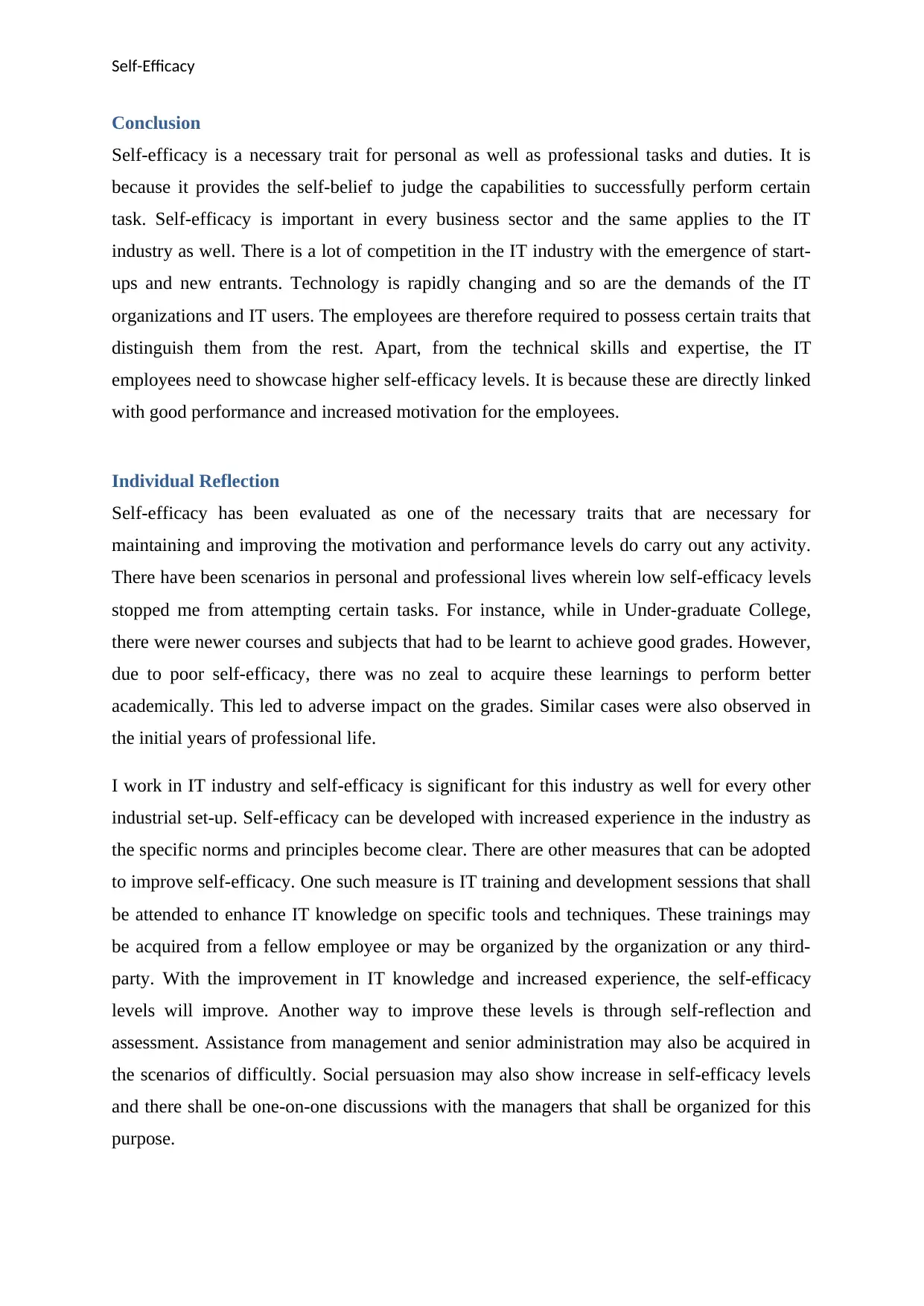
Self-Efficacy
Conclusion
Self-efficacy is a necessary trait for personal as well as professional tasks and duties. It is
because it provides the self-belief to judge the capabilities to successfully perform certain
task. Self-efficacy is important in every business sector and the same applies to the IT
industry as well. There is a lot of competition in the IT industry with the emergence of start-
ups and new entrants. Technology is rapidly changing and so are the demands of the IT
organizations and IT users. The employees are therefore required to possess certain traits that
distinguish them from the rest. Apart, from the technical skills and expertise, the IT
employees need to showcase higher self-efficacy levels. It is because these are directly linked
with good performance and increased motivation for the employees.
Individual Reflection
Self-efficacy has been evaluated as one of the necessary traits that are necessary for
maintaining and improving the motivation and performance levels do carry out any activity.
There have been scenarios in personal and professional lives wherein low self-efficacy levels
stopped me from attempting certain tasks. For instance, while in Under-graduate College,
there were newer courses and subjects that had to be learnt to achieve good grades. However,
due to poor self-efficacy, there was no zeal to acquire these learnings to perform better
academically. This led to adverse impact on the grades. Similar cases were also observed in
the initial years of professional life.
I work in IT industry and self-efficacy is significant for this industry as well for every other
industrial set-up. Self-efficacy can be developed with increased experience in the industry as
the specific norms and principles become clear. There are other measures that can be adopted
to improve self-efficacy. One such measure is IT training and development sessions that shall
be attended to enhance IT knowledge on specific tools and techniques. These trainings may
be acquired from a fellow employee or may be organized by the organization or any third-
party. With the improvement in IT knowledge and increased experience, the self-efficacy
levels will improve. Another way to improve these levels is through self-reflection and
assessment. Assistance from management and senior administration may also be acquired in
the scenarios of difficultly. Social persuasion may also show increase in self-efficacy levels
and there shall be one-on-one discussions with the managers that shall be organized for this
purpose.
Conclusion
Self-efficacy is a necessary trait for personal as well as professional tasks and duties. It is
because it provides the self-belief to judge the capabilities to successfully perform certain
task. Self-efficacy is important in every business sector and the same applies to the IT
industry as well. There is a lot of competition in the IT industry with the emergence of start-
ups and new entrants. Technology is rapidly changing and so are the demands of the IT
organizations and IT users. The employees are therefore required to possess certain traits that
distinguish them from the rest. Apart, from the technical skills and expertise, the IT
employees need to showcase higher self-efficacy levels. It is because these are directly linked
with good performance and increased motivation for the employees.
Individual Reflection
Self-efficacy has been evaluated as one of the necessary traits that are necessary for
maintaining and improving the motivation and performance levels do carry out any activity.
There have been scenarios in personal and professional lives wherein low self-efficacy levels
stopped me from attempting certain tasks. For instance, while in Under-graduate College,
there were newer courses and subjects that had to be learnt to achieve good grades. However,
due to poor self-efficacy, there was no zeal to acquire these learnings to perform better
academically. This led to adverse impact on the grades. Similar cases were also observed in
the initial years of professional life.
I work in IT industry and self-efficacy is significant for this industry as well for every other
industrial set-up. Self-efficacy can be developed with increased experience in the industry as
the specific norms and principles become clear. There are other measures that can be adopted
to improve self-efficacy. One such measure is IT training and development sessions that shall
be attended to enhance IT knowledge on specific tools and techniques. These trainings may
be acquired from a fellow employee or may be organized by the organization or any third-
party. With the improvement in IT knowledge and increased experience, the self-efficacy
levels will improve. Another way to improve these levels is through self-reflection and
assessment. Assistance from management and senior administration may also be acquired in
the scenarios of difficultly. Social persuasion may also show increase in self-efficacy levels
and there shall be one-on-one discussions with the managers that shall be organized for this
purpose.
⊘ This is a preview!⊘
Do you want full access?
Subscribe today to unlock all pages.

Trusted by 1+ million students worldwide
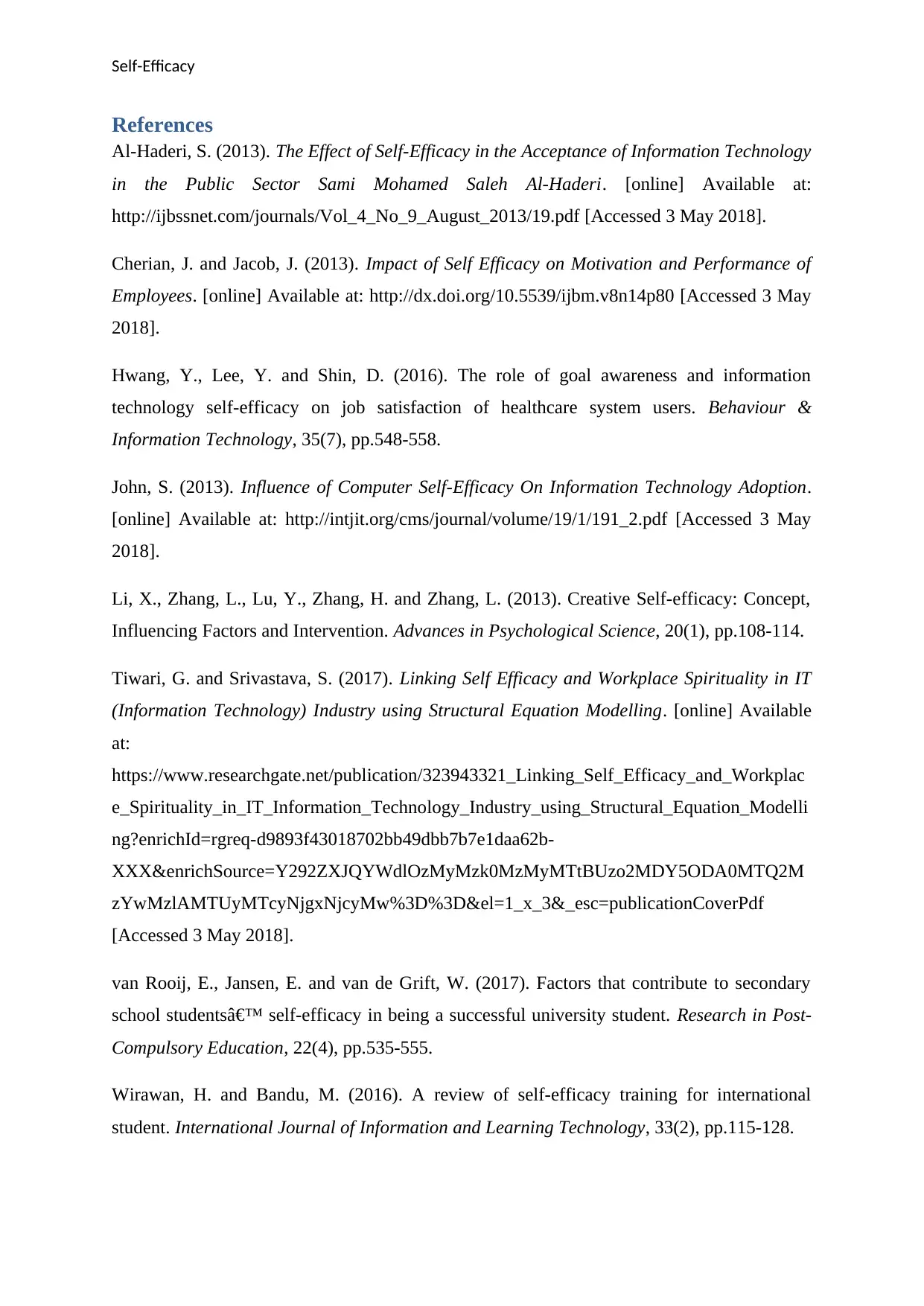
Self-Efficacy
References
Al-Haderi, S. (2013). The Effect of Self-Efficacy in the Acceptance of Information Technology
in the Public Sector Sami Mohamed Saleh Al-Haderi. [online] Available at:
http://ijbssnet.com/journals/Vol_4_No_9_August_2013/19.pdf [Accessed 3 May 2018].
Cherian, J. and Jacob, J. (2013). Impact of Self Efficacy on Motivation and Performance of
Employees. [online] Available at: http://dx.doi.org/10.5539/ijbm.v8n14p80 [Accessed 3 May
2018].
Hwang, Y., Lee, Y. and Shin, D. (2016). The role of goal awareness and information
technology self-efficacy on job satisfaction of healthcare system users. Behaviour &
Information Technology, 35(7), pp.548-558.
John, S. (2013). Influence of Computer Self-Efficacy On Information Technology Adoption.
[online] Available at: http://intjit.org/cms/journal/volume/19/1/191_2.pdf [Accessed 3 May
2018].
Li, X., Zhang, L., Lu, Y., Zhang, H. and Zhang, L. (2013). Creative Self-efficacy: Concept,
Influencing Factors and Intervention. Advances in Psychological Science, 20(1), pp.108-114.
Tiwari, G. and Srivastava, S. (2017). Linking Self Efficacy and Workplace Spirituality in IT
(Information Technology) Industry using Structural Equation Modelling. [online] Available
at:
https://www.researchgate.net/publication/323943321_Linking_Self_Efficacy_and_Workplac
e_Spirituality_in_IT_Information_Technology_Industry_using_Structural_Equation_Modelli
ng?enrichId=rgreq-d9893f43018702bb49dbb7b7e1daa62b-
XXX&enrichSource=Y292ZXJQYWdlOzMyMzk0MzMyMTtBUzo2MDY5ODA0MTQ2M
zYwMzlAMTUyMTcyNjgxNjcyMw%3D%3D&el=1_x_3&_esc=publicationCoverPdf
[Accessed 3 May 2018].
van Rooij, E., Jansen, E. and van de Grift, W. (2017). Factors that contribute to secondary
school students’ self-efficacy in being a successful university student. Research in Post-
Compulsory Education, 22(4), pp.535-555.
Wirawan, H. and Bandu, M. (2016). A review of self-efficacy training for international
student. International Journal of Information and Learning Technology, 33(2), pp.115-128.
References
Al-Haderi, S. (2013). The Effect of Self-Efficacy in the Acceptance of Information Technology
in the Public Sector Sami Mohamed Saleh Al-Haderi. [online] Available at:
http://ijbssnet.com/journals/Vol_4_No_9_August_2013/19.pdf [Accessed 3 May 2018].
Cherian, J. and Jacob, J. (2013). Impact of Self Efficacy on Motivation and Performance of
Employees. [online] Available at: http://dx.doi.org/10.5539/ijbm.v8n14p80 [Accessed 3 May
2018].
Hwang, Y., Lee, Y. and Shin, D. (2016). The role of goal awareness and information
technology self-efficacy on job satisfaction of healthcare system users. Behaviour &
Information Technology, 35(7), pp.548-558.
John, S. (2013). Influence of Computer Self-Efficacy On Information Technology Adoption.
[online] Available at: http://intjit.org/cms/journal/volume/19/1/191_2.pdf [Accessed 3 May
2018].
Li, X., Zhang, L., Lu, Y., Zhang, H. and Zhang, L. (2013). Creative Self-efficacy: Concept,
Influencing Factors and Intervention. Advances in Psychological Science, 20(1), pp.108-114.
Tiwari, G. and Srivastava, S. (2017). Linking Self Efficacy and Workplace Spirituality in IT
(Information Technology) Industry using Structural Equation Modelling. [online] Available
at:
https://www.researchgate.net/publication/323943321_Linking_Self_Efficacy_and_Workplac
e_Spirituality_in_IT_Information_Technology_Industry_using_Structural_Equation_Modelli
ng?enrichId=rgreq-d9893f43018702bb49dbb7b7e1daa62b-
XXX&enrichSource=Y292ZXJQYWdlOzMyMzk0MzMyMTtBUzo2MDY5ODA0MTQ2M
zYwMzlAMTUyMTcyNjgxNjcyMw%3D%3D&el=1_x_3&_esc=publicationCoverPdf
[Accessed 3 May 2018].
van Rooij, E., Jansen, E. and van de Grift, W. (2017). Factors that contribute to secondary
school students’ self-efficacy in being a successful university student. Research in Post-
Compulsory Education, 22(4), pp.535-555.
Wirawan, H. and Bandu, M. (2016). A review of self-efficacy training for international
student. International Journal of Information and Learning Technology, 33(2), pp.115-128.
1 out of 7
Related Documents
Your All-in-One AI-Powered Toolkit for Academic Success.
+13062052269
info@desklib.com
Available 24*7 on WhatsApp / Email
![[object Object]](/_next/static/media/star-bottom.7253800d.svg)
Unlock your academic potential
Copyright © 2020–2025 A2Z Services. All Rights Reserved. Developed and managed by ZUCOL.





